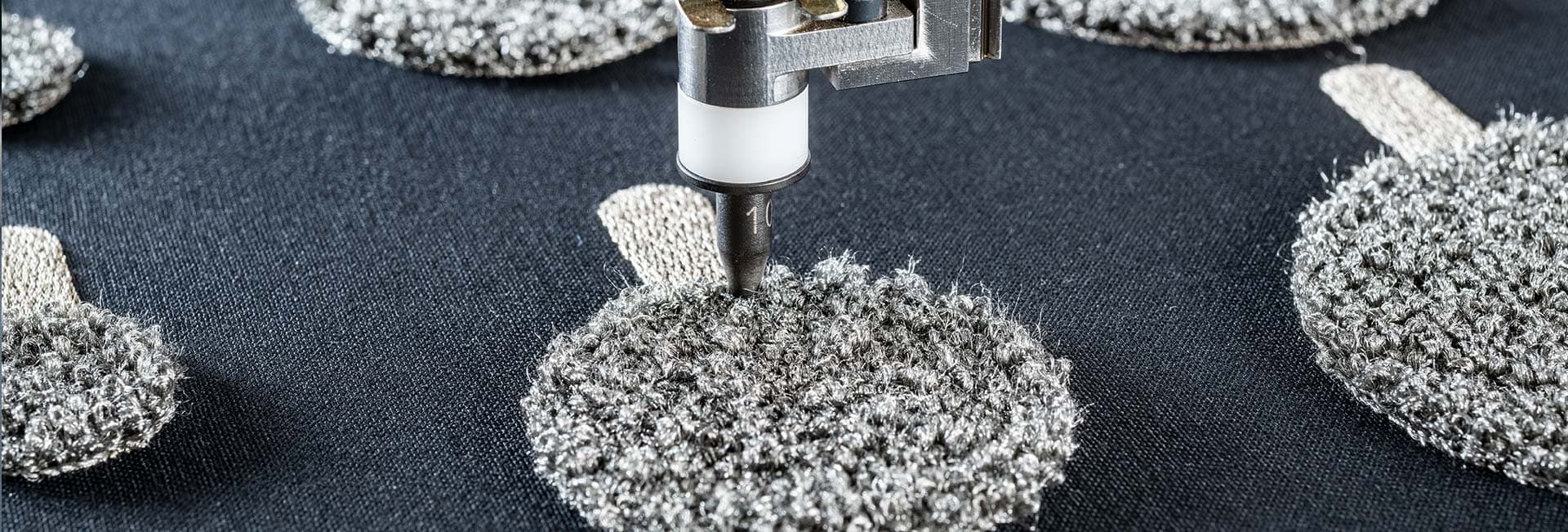Moss Embroidery with Sensors – Methods and Applications for Biomedical Signal Collection
Its versatility and use for eclectic signal types and biometrics make moss embroidery an important method for biometric signal collection from patients. High customization and automatic embroidered production and low cost – moss electrodes offer many advantages, in particular when compared to common procedures.
Traditional electrodes utilize a conductive pad, usually copper, as the electrical receptor with a thin layer of saline gel between the pad and the skin in order to boost interfacial conductivity. Often, the perimeter of traditional electrodes includes an adhesive to help hold the electrode against the skin. While functional, this traditional method of electrode placement has significant drawbacks. Observations in longer electrode tests reveal that the saline gel can begin to dry. Thereby the conductivity decreases over the course of the test. As the material dries it can also cause skin irritation under the electrodes. This is particularly undesirable in tests where the patient takes the equipment home for an extended period of time. Another drawback of traditional electrodes is the geometry of the wide copper pads which can decrease the available electrode density. This is particularly important with infants and high density multi-signal technologies like electroencephalograms. In addition, the adhesives used to secure the electrodes to the skin can occasionally cause skin irritations for some skin types.
Robust and Form Fitting Electrodes
Moss embroidery techniques derive from traditional chenille fabric techniques where tufts of thread were used to create thicker materials such as towels and piled carpet. By creating long loops of material protruding from the base material, different textures and geometric compliance can be controlled. This creates form fitting electrodes within an additional stabilization structure.
Moss embroidery with conductive thread is particularly useful when applied as electrodes due to its high surface area. As the conductive fibers are compressed against the tissue, they spread across the surface compliantly. The conductive thread already has an extremely high surface area. However, its conductivity is increased as the individual thread tufts are compressed against the skin’s surface conformingly. This creates robust and form fitting electrodes that can be incorporated into a garment or additional carrier structure.
Fixing of Sensors
Textile based electrodes do not require additional saline or conductive gels due to the thread’s high surface area. Furthermore, adhesives are not required as the sensor can be directly embroidered into a compressive garment that comfortably holds it in the correct location. This can be particularly useful with infants.
Furthermore, the application field of moss embroidered electrodes is not limited to body signal monitoring and input. They can also be used as an output device for electro-stimulation therapy of muscles and nerves for physical theory and tissue rehabilitation.
Development Kit for Moss Embroidered Electrodes
We offer a development kit of moss embroidered electrodes. It allows you to quickly and reliably test the electrodes and their function in specific applciations. The following versions are currently available:
| Description | Content | Material | |
| Development Kit Textile Moss Embroidered Electrodes – round – 33/10 with embroidered connection area | 3 x Ø 20 mm 3 x Ø 43 mm 3 x Ø 65 mm |
STATEX Shieldex® 33/10 dtex Z turns | Buy at ZSK Online Shop |
| Development Kit Textile Moss Embroidered Electrodes - round – 78/18 with embroidered connection area | 3 x Ø 20 mm 3 x Ø 43 mm 3 x Ø 65 mm |
STATEX Shieldex® 78/20 dtex Z turns +B | Buy at ZSK Online Shop |
| Development Kit Textile Moss Embroidered Electrodes - round – 235/36 with embroidered connection area | 3 x Ø 20 mm 3 x Ø 43 mm 3 x Ø 65 mm |
STATEX Shieldex® 235/36 dtex 2-ply HC +B | Buy at ZSK Online Shop |

